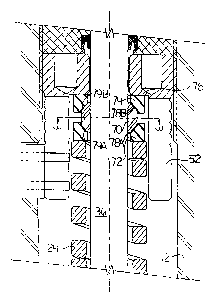Une partie des informations de ce site Web a été fournie par des sources externes. Le gouvernement du Canada n'assume aucune responsabilité concernant la précision, l'actualité ou la fiabilité des informations fournies par les sources externes. Les utilisateurs qui désirent employer cette information devraient consulter directement la source des informations. Le contenu fourni par les sources externes n'est pas assujetti aux exigences sur les langues officielles, la protection des renseignements personnels et l'accessibilité.
L'apparition de différences dans le texte et l'image des Revendications et de l'Abrégé dépend du moment auquel le document est publié. Les textes des Revendications et de l'Abrégé sont affichés :
| (12) Brevet: | (11) CA 2189608 |
|---|---|
| (54) Titre français: | MANOCONTACT A ZONE MORTE ACCRUE |
| (54) Titre anglais: | PRESSURE SWITCH WITH INCREASED DEADBAND |
| Statut: | Durée expirée - au-delà du délai suivant l'octroi |
| (51) Classification internationale des brevets (CIB): |
|
|---|---|
| (72) Inventeurs : |
|
| (73) Titulaires : |
|
| (71) Demandeurs : |
|
| (74) Agent: | LAMBERT INTELLECTUAL PROPERTY LAW |
| (74) Co-agent: | |
| (45) Délivré: | 2004-02-24 |
| (22) Date de dépôt: | 1996-11-05 |
| (41) Mise à la disponibilité du public: | 1998-05-05 |
| Requête d'examen: | 1999-09-23 |
| Licence disponible: | S.O. |
| Cédé au domaine public: | S.O. |
| (25) Langue des documents déposés: | Anglais |
| Traité de coopération en matière de brevets (PCT): | Non |
|---|
| (30) Données de priorité de la demande: | S.O. |
|---|
Manocontact doté d'un logement avec un alésage intérieur s'étendant d'une extrémité à l'autre. Une tige coulissante dans l'alésage et fonctionnant par pression extérieure de liquide s'étend entre un piston à une extrémité du logement et un commutateur électrique à fonctionnement mécanique à l'autre extrémité du logement. Un ressort est disposé autour de la tige entre une première butée sur la tige et une seconde butée sur le logement. Le ressort fournit une résistance contre le mouvement de la tige sous la pression extérieure. La résistance du ressort au mouvement est réglée par un manche engageant le ressort, le manche étant fileté dans l'alésage du logement pour un mouvement longitudinal dans le logement. Un anneau ouvert est coincé entre les deux autres anneaux résiste au mouvement de la tige vers le mouvement longitudinal.
A pressure switch has a housing with an interior bore extending from one end to the other. A rod slidable within the bore and operated by external fluid pressure extends between a piston at one end of the housing and a mechanically operated electrical switch at the other end of the housing. A spring is disposed about the rod between a first stop on the rod and a second stop on the housing. The spring provides resistance against movement of the rod under external pressure. The resistance of the spring to movement is adjusted by a sleeve engaging the spring, with the sleeve threaded into the bore of the housing for movement longitudinally within the housing. A split ring wedged between two other rings resists movement of the rod to longitudinal movement.
Note : Les revendications sont présentées dans la langue officielle dans laquelle elles ont été soumises.
Note : Les descriptions sont présentées dans la langue officielle dans laquelle elles ont été soumises.

2024-08-01 : Dans le cadre de la transition vers les Brevets de nouvelle génération (BNG), la base de données sur les brevets canadiens (BDBC) contient désormais un Historique d'événement plus détaillé, qui reproduit le Journal des événements de notre nouvelle solution interne.
Veuillez noter que les événements débutant par « Inactive : » se réfèrent à des événements qui ne sont plus utilisés dans notre nouvelle solution interne.
Pour une meilleure compréhension de l'état de la demande ou brevet qui figure sur cette page, la rubrique Mise en garde , et les descriptions de Brevet , Historique d'événement , Taxes périodiques et Historique des paiements devraient être consultées.
| Description | Date |
|---|---|
| Exigences relatives à la nomination d'un agent - jugée conforme | 2020-04-22 |
| Exigences relatives à la révocation de la nomination d'un agent - jugée conforme | 2020-04-22 |
| Inactive : Périmé (brevet - nouvelle loi) | 2016-11-05 |
| Inactive : Lettre officielle | 2007-07-13 |
| Inactive : Lettre officielle | 2007-07-13 |
| Demande visant la nomination d'un agent | 2007-07-09 |
| Demande visant la révocation de la nomination d'un agent | 2007-07-09 |
| Accordé par délivrance | 2004-02-24 |
| Inactive : Page couverture publiée | 2004-02-23 |
| Inactive : Taxe finale reçue | 2003-12-10 |
| Préoctroi | 2003-12-10 |
| Un avis d'acceptation est envoyé | 2003-06-18 |
| Lettre envoyée | 2003-06-18 |
| Un avis d'acceptation est envoyé | 2003-06-18 |
| Inactive : Approuvée aux fins d'acceptation (AFA) | 2003-05-28 |
| Inactive : Dem. traitée sur TS dès date d'ent. journal | 1999-10-13 |
| Lettre envoyée | 1999-10-13 |
| Inactive : Renseign. sur l'état - Complets dès date d'ent. journ. | 1999-10-13 |
| Toutes les exigences pour l'examen - jugée conforme | 1999-09-23 |
| Exigences pour une requête d'examen - jugée conforme | 1999-09-23 |
| Demande publiée (accessible au public) | 1998-05-05 |
Il n'y a pas d'historique d'abandonnement
Le dernier paiement a été reçu le 2003-10-21
Avis : Si le paiement en totalité n'a pas été reçu au plus tard à la date indiquée, une taxe supplémentaire peut être imposée, soit une des taxes suivantes :
Veuillez vous référer à la page web des taxes sur les brevets de l'OPIC pour voir tous les montants actuels des taxes.
Les titulaires actuels et antérieures au dossier sont affichés en ordre alphabétique.
| Titulaires actuels au dossier |
|---|
| ARGUS MACHINE CO. LTD. |
| Titulaires antérieures au dossier |
|---|
| JAMES RICHARD ELLETT |